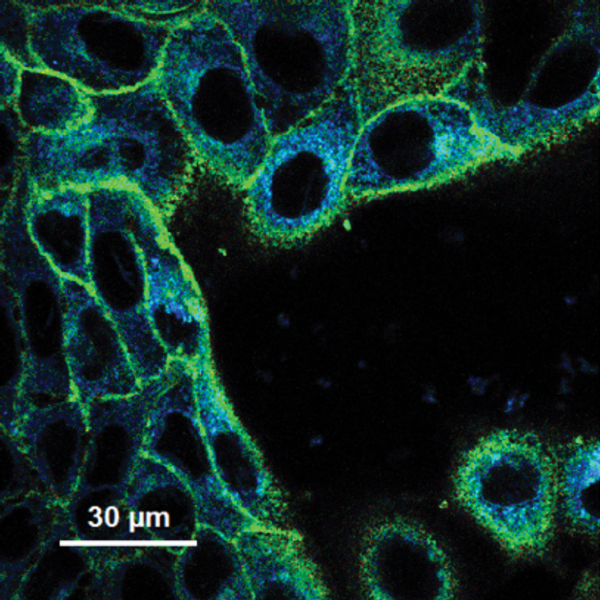With a focus on methods development with regard to biomembranes, five NCCR research teams strive to establish conceptually innovative approaches to cross membrane barriers and enter cells, and to image biologically important properties of biomembranes that are otherwise difficult to detect.
Interview with Professor Stefan Matile, Project Leader

Can you shed light on the project and describe the selected approaches used?
For imaging, we have introduced fluorescent probes that change color like lobsters during cooking. The same combination of polarization and planarization accounts for the chemistry of vision, particularly color vision. We were thus surprised to realize that this winning combination has not been used before to create new fluorescent probes and just thought we should try and see what we can get.
For uptake, we aim to apply lessons from supramolecular organic chemistry and, at best, run covalent chemistry directly on cell surfaces. This begins the introduction of quite special interactions to active cell-penetrating peptides and continues with poly(disulfide)s to mix in disulfide exchange for thiol-mediated uptake. Most recent and most innovative certainly is the use of disulfide ring tension. Ring strain is the key to operate molecules that have changed our world, like the penicillins to treat bacterial infection, or several antitumor agents, mitomycin C and beyond. We hope that the release of ring tension on the cell surface will be similarly effective to open new doors to enter into cells.
What are the main scientific advances achieved by your project after 6 years of research and during this past year in particular?
We have created fluorescent membrane probes that image differently and transporters that deliver differently, all as promised. When it comes to truly fundamental recent progress, the discovery of strain-promoted uptake certainly stands out, including the first proteomics analysis from the Adibekian group. This could be a game-changer, we will see.
Did you face any experimental or intellectual roadblocks? How did you deal with it?
With ambitious and innovative research, there is always plenty of this. For example, some time ago we realized that both brightness and mechanosensitivity of our probes would never be sufficient to image in cells. In her group meeting, Marta Dal Molin, the postdoc working on the topic, projected a scuba diver with brightly fluorescent flippers as her idea how to solve the problem. To her puzzled audience, Marta explained that all we need are monomers that are bright enough to keep on shining also when twisted out of conjugation and have a large enough surface area to feel the environment really well. This worked. Since then, we refer to our mechanophores as “flipper probes”, and Marta’s scuba diver is remembered on the frontispiece in a top chemistry journal, with a water color painting from an anonymous painter (not me).
Another example is the sudden loss of the headgroup in the original flipper probes. What a dramatic process, a guillotinylation on the molecular level. A comprehensive mechanistic analysis readily revealed the structural changes needed to stop this molecular tragedy to occur. This example is also a great illustration why a thorough understanding of the involved chemistry is mandatory before “throwing new probes at cells”, particularly if they are meant to address significant challenges in biology.
Your research is at the interface of synthetic organic, biological and supramolecular chemistry. Principal investigators of the current project are coming from different fields. How multidisciplinarity has benefited the project to face challenges?
New adventures always start with the design, the great ideas, with input from everyone, from all directions. Then comes synthesis, the creation of new matter, with organic chemists taking the lead. The evaluation of the new tools then requires expertise from bioorganic chemistry, membrane biophysics, device engineering, molecular modeling and ultrafast photophysics to ultimately move on toward cellular biology. It is just so cool to have most of these expertises unified in one NCCR and see students from different background working together to ask the really important questions, learning from each other. It is this added value that makes the NCCR so special. We are all immensely grateful to be part of it, enjoy so much what we are doing and couldn’t do it without the NCCR.
What do you think is going to be the greatest impact or possible applications of the project for life sciences?
Currently I would bet on strain-promoted uptake, but you always expect most from what is newest. General, reliable and efficient cellular uptake is one of the central current challenges in chemistry and biology. It would be just wonderful if we would find the transporters everybody will use for delivery in the future, also with regard to public health. Although most exciting and timely, mechanosensitive membrane probes target a clearly smaller community.
What is your vision about the next generation of biomembrane probes?
All I can say at this point is that we plan to apply the lessons learned to fluorophores that have marked the history of Switzerland, with regard both science and economy, literally contributing to our current quality of life. Pertinent literature implies that they have all it takes to also land a big hit as flipper probes.
 Stefan Matile is a Full Professor in the Department of Organic Chemistry at the University of Geneva and a founding member of the National Centre of Competence in Research (NCCR) Chemical Biology and the NCCR Molecular Systems Engineering.
Stefan Matile is a Full Professor in the Department of Organic Chemistry at the University of Geneva and a founding member of the National Centre of Competence in Research (NCCR) Chemical Biology and the NCCR Molecular Systems Engineering.

Leave a comment
The editors reserve the right not to publish comments or to abridge them.